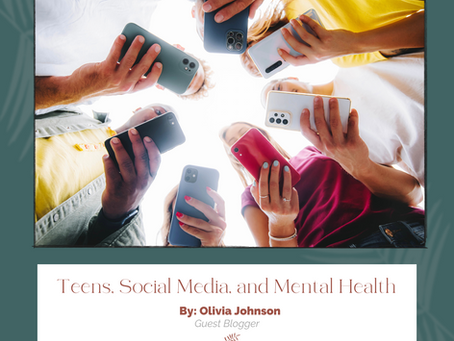top of page
Compassionate Counselling for Children, Adolescents (Teens) and Families
#TipstoBloom

Inspiration


Why Summer Is the Perfect Time to Support Your Child’s Mental Health
Summer often brings a much-needed break from the demands of the school year. The busy mornings, full days, homework struggles, and social pressures suddenly slow down. But while summer offers a pause from academics, it can be one of the most important seasons to invest in your child or teen’s mental health.
Melissa Fellin
Jul 142 min read


Teens, Social Media, and Mental Health
According to Statistics Canada (2024), 91% of young Canadians aged 15-24 regularly used social networking sites. With the majority of our teens active on social media it is crucial that as parents, caregivers, educators, professionals etc, we are paying attention to the world that so many teens are engaged in.
Olivia Johnson
Apr 14, 20242 min read


Screen Time for Young Children
Your child’s brain does the majority of its development in the first 5 years of life, meaning the first 5 years are a beautiful opportunity to help foster your child’s ability to learn, think and create meaningful attachments. Join MSW Intern Olivia Johnston for a webinar designed for parents, caregivers, educators, professionals and any other adult looking to learn, for a webinar focusing on the effects that excessive screen time can have on a child’s developing brain.
Olivia Johnson
Apr 14, 20242 min read


Opportunities to Bloom with a Student Intern as your Therapist
When you are choosing a therapist for your child or teen, it can feel overwhelming. You may also be given the option of a student intern from the organization you connect with. Many families may shy away from this option, for the reason that they are unsure if a student has the skills and abilities to best support their child. However, there are many benefits of working with a student intern as your therapist!
Lauren Galea
Dec 11, 20232 min read


Brain Development
Let’s talk about brain development!
Brain development is such an important part of understanding and making sense of behaviours, thoughts and feelings.
When thinking about how a brain develops, it can be helpful to think about it the same way a house is built.
Lauren Galea
Dec 4, 20233 min read


What is Attachment?
Attachment refers to the relationships and bonds between people. These bonds start to form at birth, and help develop a child’s sense of security in their world. It is important for children to have secure attachments to their caregivers because this supports trust and paves the way for children to develop healthy relationships in other areas of their lives. The attachment between a caregiver and child is also a key component to a child’s emotional growth and development.
Lauren Galea
Nov 9, 20232 min read


Body Breaks
What are Body Breaks?
For children with ADHD, or simply with a lot of energy, it can be difficult to maintain focus on a task for long periods of time. Body breaks can help release feelings of frustration and stress, increase focus and stay on task, and they can help a child learn how to self regulate.
Grace Ohrling
Oct 29, 20232 min read


Anxiety Attacks vs Panic Attacks
Anxiety is a term that is often used in everyday conversation to describe our children, ourselves, or others around us. Anxiety is an emotion coupled with feelings of uneasiness, worry, and intrusive thoughts which may occur as a response to a present or perceived threat. When individuals feel anxious, they may experience physical symptoms such as an increased heart rate, sweating, increase in temperature, uneasy stomach, or restlessness.
Olivia Holden BSW, RSW
Sep 24, 20233 min read


Parenting With 2SLGBTQIA+ Inclusive Language
Happy Pride Month! Pride month is the perfect time to reflect on our use of inclusive language in all aspects of our lives including parenting. Whether you know if your child identifies as 2SLGBTQIA+ or not, there are a few things you can do to make them feel more comfortable with sharing their identity, and supporting their peers as well. This includes language that includes various gender identities, diverse families, and romantic partners.
Grace Ohrling
Jun 19, 20233 min read


What is Neurodiversity?
The term neurodiversity describes the natural cognitive differences between individuals, including brain function and behavioral traits. Just like racial, gender, and cultural diversity, variations in neurotypes are natural and valuable forms of human diversity!
Grace Ohrling
Jun 7, 20232 min read
bottom of page
